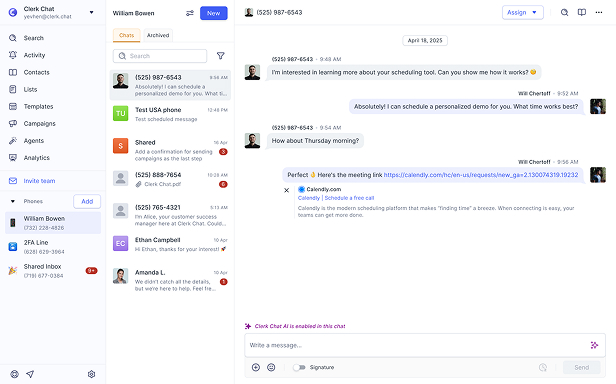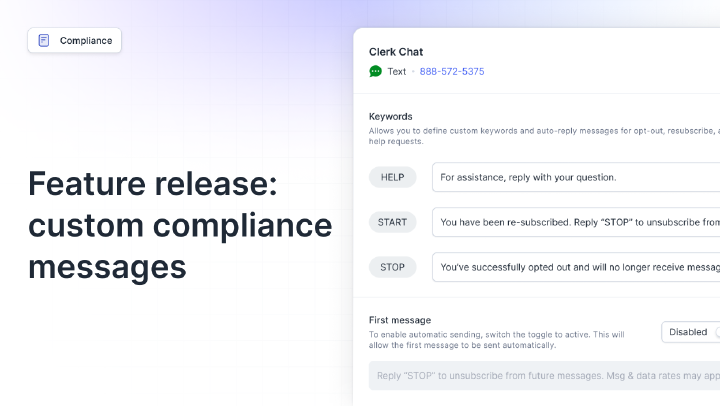SMS Compliance
[ˈɛs ˈɛm ˈɛs kəmˈplaɪəns]SMS compliance refers to the legal and ethical standards businesses must follow when sending text messages to customers. It ensures that recipients have consented to receive texts and that businesses follow regulations designed to protect consumer privacy and trust.
Why SMS compliance matters
For any business that uses texting to communicate with customers - whether for promotions, appointment reminders, or support - compliance isn’t optional. It builds trust with recipients, improves deliverability rates, and protects your brand from legal issues.
Non-compliance can lead to serious consequences: blocked messages, fines, or lawsuits. Regulations like the Telephone Consumer Protection Act (TCPA) and guidelines from the CTIA and mobile carriers govern how texts must be sent, including rules on consent, content, frequency, and opt-out mechanisms.
Compliance also ensures message quality and clarity. When customers receive transparent, timely, and consent-based texts, they’re more likely to engage. In competitive industries, this trust can become a key differentiator.
How SMS compliance works
Here’s how businesses typically implement SMS compliance:
- Get explicit opt-in – Customers must actively agree to receive texts, usually via checkboxes, keyword texts, or forms.
- Send confirmation messages – Double opt-in flows confirm consent and document the user’s intent.
- Honor opt-outs – Every message must include clear instructions on how to unsubscribe (e.g., “Reply STOP to opt out”).
- Keep consent records – Logs should be maintained to show when, where, and how consent was granted.
- Register for 10DLC – In the US, carriers require businesses to register their use cases to prevent spam and improve deliverability.
- Use approved templates – Some messages, like those sent via short codes or RCS, may require pre-approved content.
- Stay updated – Regulations and industry standards evolve. Businesses must review their compliance setup regularly.
Best practices with SMS compliance
Use clear opt-in language – Let users know what they’re signing up for, including message frequency and type.
Implement double opt-in – This extra layer confirms user intent and provides proof of consent.
Include opt-out instructions – Every message should make it easy to unsubscribe. Automate this in your platform.
Regularly audit your list – Remove inactive or non-compliant contacts and update consent logs.
Register campaigns properly – For 10DLC or short code campaigns, ensure registration is complete and accurate.
Segment your audience – Don’t blast messages. Target users based on their preferences and consent history.
Monitor carrier feedback – Pay attention to delivery reports and error messages to fix compliance issues early.
Real world examples
- Healthcare
Reduced opt-out rates by 28% after adding double opt-in flow.
Read more - Ecommerce
Avoided fines and improved delivery by using 10DLC-compliant messaging.
Read more
Common misconceptions
While the US has strict rules (TCPA, CTIA), many other countries have their own regulations too.
Compliance applies to all types of SMS - marketing, transactional, and even internal notifications.
True consent requires explicit opt-in for specific use - just providing a number isn’t enough.
Compliance is ongoing - policies, audits, and subscriber preferences must be maintained consistently.
Every SMS campaign must offer a clear and easy opt-out option, regardless of content value.
Related terms
In this article:
Ready to use your business number for text messaging?
Thousands of businesses are already experiencing the power of conversational messaging through SMS. Join us. Free trial and paid tiers available.
Get StartedFAQ
Have questions? We've got answers.
Find what you need quickly and clearly with our most frequently asked questions.
SMS compliance refers to adhering to legal and industry standards (like TCPA, CTIA, and 10DLC rules) to ensure messages are sent lawfully. It helps protect user privacy, maintain trust, and avoid legal risks or penalties.
Start with clear opt-in/opt-out processes, use compliant carriers like 10DLC, include required disclosures, and regularly audit your contact lists. Clerk Chat offers built-in compliance features to make this easier.
There’s no direct fee for compliance, but using compliant infrastructure (like 10DLC registration) can incur modest carrier fees. The cost of non-compliance - penalties or blocked messages - is much higher.
TCPA is a federal law with legal penalties; CTIA provides industry guidelines for best practices. Both are important - one protects from lawsuits, the other improves deliverability and reputation.
Yes. Whether messages are sent by humans or AI, compliance rules apply. Clerk Chat’s AI is built to respect opt-outs, consent, and message frequency limits automatically.
Use confirmed opt-ins, personalize messages responsibly, honor opt-outs immediately, and maintain records of consent. Compliance becomes easier with platforms that enforce these standards automatically.




